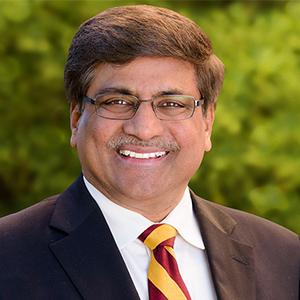CT Stories
Catalyzing NextG networking

As the world grows more interconnected, the communication networking and computing industries are at the precipice of a new chapter in digital technology. The ever-increasing fusion of mass-scale connectivity, artificial intelligence, and autonomous machines will enable digital experiences unlike anything that is seen before. To get there, the industry needs a different breed of communication networks than the currently existing ones. One that is smarter, more reliable, and more secure. A network that can re-architect itself on the fly to adapt to newly discovered threats and constantly evolving needs.
The National Science Foundation (NSF), an independent agency of the United States government that supports fundamental research and education in all the non-medical fields of science and engineering is leading a public-private partnership to figure out what comes next after 5G. NSF, the Defense Department, the National Institute of Standards and Technology, and leading private sector technology firms are investing USD 40 million into the Resilient and Intelligent Next-Generation Systems program, or RINGS. RINGS seeks to accelerate research in areas with potentially significant impact on next-generation networking and computing systems. NextG systems are future versions of today’s cellular, Wi-Fi, and satellite networks.
The need of resilient and intelligent networks. Communication networks are a critical part of societal infrastructure – just like power, water, and transportation. But today’s communication networks are not resilient or performant enough to support emerging NextG critical and essential services, which range from communication to computation to intelligent decision-making.
Traditional network design has been narrowly focused. These solutions do not yet address network resilience in a comprehensive, integrated manner, which has led to a world where factors such as security vulnerabilities, unstable updates, and misconfigured systems create unpredictable behaviors. While tolerated in today’s networks, these unpredictable behaviors are unacceptable in a NextG network system. In contrast, the networks of the future require a system-level mindset that addresses all layers of the protocol stack.
The NSF is not inclined to wait for NextG networks. And who can blame it? For the NSF, NextG network translates into improved national defense, education, public health and safety, transportation, and digital infrastructure. For enterprises, NextG means greater efficiency, flexibility, business insights, and more opportunities to replace human workers with robots.
Imagine offering dwindling number of human employees’ connectivity speeds of 1 Gbps or more, along with latencies as low as 1 millisecond or less for massive numbers of devices and services.
This would enable applications such as AR/VR and video analytics. NextG networks will leverage SDN, programmable accelerators, network function virtualization (NFV), cloud-computing platforms, dynamic orchestration, and mobile edge computing (MEC).
Once fully deployed, NextG network systems will provide connectivity for billions of internet-of-things devices and billions of people around the world. It will enable machines to communicate with each other and will make compute and storage resources available on-demand at the edge and from the cloud.
The economy will become ever more dependent on the high availability, security, and reliability of such network systems. Sounds great! Well, except for the dependent part as any failure, tampering, or degradation in network service can have highly disruptive, if not potentially catastrophic, effects.
The NSF, 10 years ago, invested in research that led to the development of 5G by showing the viability of technologies including mmWave and spectrum sharing. The agency is hoping to do the same again with the NextG of connectivity technology, but through a more collaborative approach. Hence, in a bid to head off this foreboding fate, the agency is coordinating efforts to unleash the immense power of innovative and cash rewards to ensure NextG network systems have high degrees of resiliency at-scale (regardless of complexity), reliability, and availability. There are several other programs across the globe aiming to address the NextG, but the NSF effort is emphasizing on boosting resilience alongside network intelligence, bandwidth, latency, and scalability.
Defining RINGS. The NSF’s RINGS program seeks to accelerate research in areas that will potentially have significant impact on emerging next-generation wireless and mobile communication, networking, sensing, and computing systems, along with global-scale services, with a focus on greatly improving the resiliency of such networked systems among other performance
metrics.
Modern communication devices, systems, and networks are expected to support a broad range of critical and essential services, incorporating computation, coordination, and intelligent decision making. Resiliency of such systems, which subsumes security, adaptability, and autonomy, will be a key driving factor for future NextG network systems.
Resiliency in both design and operations ensures robust network and computing capabilities that exhibit graceful performance- and service-degradation with rapid adaptability under even extreme operating scenarios. The program seeks innovations to enhance both resiliency as well as performance across the various aspects of NextG communications, networking, and computing systems.
It seeks to go beyond the current research portfolio within the individual participating directorates by simultaneously emphasizing gains in resiliency across all layers of the networking protocol and computation stacks as well as in throughput, latency, and connection density.
Notably, the NSF is stressing the importance of resilience in these next-generation systems in order for them to survive, gracefully adapt to, and rapidly recover from malicious attacks, component failures, and natural and human-induced disruptions. With escalating incursions from unfriendly international actors – example, the high-profile SolarWinds attack, which involved Russian hackers compromising a network monitoring service – the renewed emphasis on and investment in network cybersecurity is well-timed.
 Sethuraman Panchanathan
Sethuraman Panchanathan
Director,
National Science Foundation
“Since I joined NSF, I have championed public-private partnerships as a critical foundation for advancing the frontiers of science and driving home solutions to some of our foremost societal challenges. I am delighted we are launching this multi-sector collaboration to drive the innovations that will shape future communication networks so vital to everyday life.”
The USD 40 million funding includes contributions from each of the partners. The private-sector partners are also offering their technical insight and expertise to the program, with an eye toward helping to accelerate resulting technologies in the future.
Proposals are now open for funding under RINGS, which the NSF calls its single largest effort to date to engage public and private partners to jointly support a research program. The program plans to award 36-48 awards, with each award including up to USD 1 million in funding across up to 3 years. The deadline for proposal submission is July 29, 2021.
Proposed projects must develop and leverage advanced radio technologies, spectrum allocation, edge/cloud computing, cognitive networks, microservices, and AI/ML. Those working on projects chosen for the program will have access not only to the industry and government partners for collaboration, but also NSF’s four wireless testbed facilities to trial their ideas.
A joint effort. In the RINGS program, NSF is partnering with the Office of the Under Secretary of Defense for Research and Engineering (OUSD R&E), the National Institute of Standards and Technology (NIST), and a number of industry partners, enlisting nine cloud, tech, and telecom heavyweights. This program seeks to fund collaborative team research that transcends the traditional boundaries of individual disciplines to achieve the program goals. The nine private partners who make up a veritable who’s who of the tech world: Apple, Ericsson, Google, IBM, Intel, Microsoft, Nokia, Qualcomm, and VMware.
 Harish Viswanathan
Harish Viswanathan
Head of the Radio Systems Research Group,
Nokia Bell Labs
“Nokia Bell Labs have been hard at work identifying the problems that future 6G systems can solve and then researching the technologies that will address those problems. We are looking forward to sharing these insights with RINGS as well, while receiving the equally compelling insights of our government, academic, and professional peers. We expect transformative innovations to emerge from this cross-disciplinary effort.”
The significance of the public-private partnership goes beyond leveraging funding. For example, private-sector partners in this coalition represent some of the users who would develop and implement NextG technologies; they bring experience and insight, as well as the potential to accelerate the translation of fundamental research findings into new technologies and solutions.
By partnering with the NSF, Google Cloud has become a part of the combined USD 40 million investment. The company will offer expertise, research collaborations, infrastructure, and in-kind support for researchers and students as they advance knowledge and progress in the field. The company directly interconnects with all major ISPs and telecom carriers and delivers traffic to users with very low latency. It is also now working on a fully managed, open, and secure modern edge cloud platform – with capabilities such as zero-touch, verifiability, closed-loop automation, and more.
Intel and NSF have a long-term commitment to driving network transformation. The company believes the RINGS program will extend and accelerate the network transformation that began with SDN and NFV and continues with advances in programmable accelerators and AI/ML solutions.
As network architectures shift to cloud-computing platforms, dynamic orchestration, and multi-access edge computing (MEC)—all deployed on industry-standard servers—more research is necessary to increase the resiliency of the network and optimize network performance to prepare for 5G and beyond.
Nokia has been instrumental in creating RINGS through early discussions with its peers. The company plans to bring to the table its: long-term industry perspective; expertise in mobile, fixed and optical networks spanning the consumer, enterprise, and industrial spheres; and long history of participating in and leading collaborative research projects with the distinguished academic partners.
Ericsson’s Group Function and Research team in Silicon Valley has been working with the NSF and industry partners to deliver on the promise of empowering an intelligent, sustainable, and connected world by looking to the next generation of today’s cellular, Wi-Fi, and satellite networks in NextG systems.
Role of industry funding partners. The partner companies have committed to providing annual contributions to NSF for the purpose of funding proposals awarded under this solicitation. The contributions from these partners have been agreed upon on the basis of a shared belief in the importance of making progress in the research, education, and workforce development goals identified in this program.
Prior to award, these partner companies will not participate in or observe the review of proposals. After completion of the merit review process, NSF may share with representatives of the industry partners the subset of proposals which are under consideration for funding by NSF, along with corresponding unattributed reviews and panel summaries. The agency will take into consideration the input of all industry funding partners prior to making final funding decisions but will retain final authority for making all award decisions.
The agency will administer awards under the program in accordance with standard NSF policies and procedures. All awards will be subject to standard NSF terms and conditions. Industry partners will not oversee the activities or use of funds by grantees under this program but may engage with grantees. Specifically, post-award, partner companies may make available direct contributions of resources including, but not limited to, software (prototypes or products), data sets, and/or other computing infrastructure. No awardee will be required to use any company’s offered contributions.
A company may also arrange to fund its own personnel as researchers to directly participate, part-time or full-time, with awardee project personnel. These arrangements will be optional and upon the mutual consent of the companies and respective awardee institutions. NSF will share annual project reports with partner companies and agencies after those reports have been reviewed and accepted by the cognizant NSF Program Officer.
The awardees shall grant to the sponsoring entities (the Federal Government and all the industry partners) a non-exclusive, worldwide, paid-up, non-transferable, royalty-free license to all intellectual property rights in any inventions or works of authorship resulting from research conducted under the program.
The license to each industry partner will include its subsidiaries and contractors, at its discretion, to the extent that such use is specifically in connection with the industry partner’s products and/or services. Awardees shall grant the license to each industry partner unless the industry partner opts to decline the license.
Enabling 5G and beyond. As global communication networks evolve through 5G, 6G and beyond, the number of connections will increase exponentially, and communications services will grow more tightly intertwined into people’s daily lives. As they do, it will become ever more important that these services are reliable and secure. The network will need to become increasingly distributed to enable new services that are more customized and on-demand. At the same time, to deliver these next-generation services, networks will need to operate not just holistically but collectively.
Furthermore, the foundation of universal autonomy is intelligence – and not just intelligence that lives in a centralized data center or cloud, but intelligence that can be distributed anywhere and everywhere. It is this distributed intelligence that will allow bridging the gap between physical and digital worlds. It will enable the progress from today’s networks, which are optimized for human-to-human and human-to-machine connections, to ones that facilitate autonomous machine-to-machine communication at massive scales. Across networks, clouds, and geographies, NextG systems will autonomously distribute intelligence everywhere, all the way to the user, to enable highly interactive immersive experiences merging digital and physical worlds.
Hence, resiliency and reliability will be critical for the networks of the future. By building in security from the start, ensuring the right policies are in place to foster the innovations and economic development these systems will provide, and bringing to bear the decades of experience in public-private partnerships, the industry can more quickly and effectively accelerate the development of research findings into new technologies and solutions.
 Bikash Koley
Bikash Koley
Vice President and Head, Google Global Networking; Head, Technology and Strategy,
Google Cloud for Telecommunications
“At Google, we have a long history of fundamental research in networking. This experience has helped us build a global and edge network infrastructure that is cloud-native, fully automated, software-defined, and extensively virtualized. In addition to funding, Google will offer expertise, research collaborations, infrastructure, and in-kind support for researchers and students as they advance knowledge and progress in the field.”
To this end, the RINGS calls for cooperative research innovation and which will most likely lead to the importance of open standards – critical pieces to enable universally autonomous networks. One of the core goals of the program is to inspire innovation to drastically reduce the vulnerable attack surface of critical systems. Indeed, while most current systems are built for performance first, resiliency second, RINGS will invert this inside-out model.













You must be logged in to post a comment Login